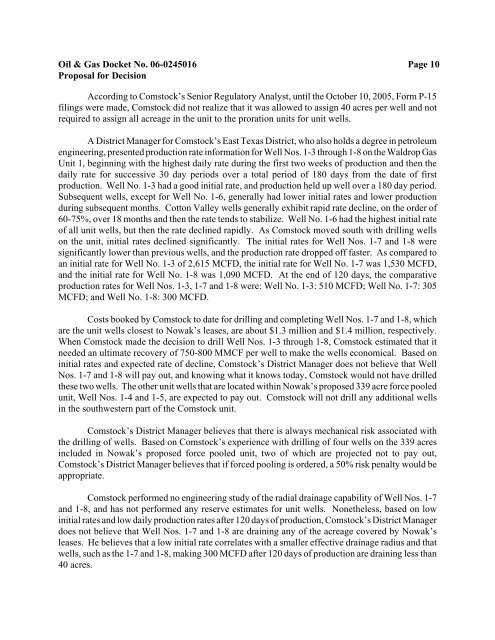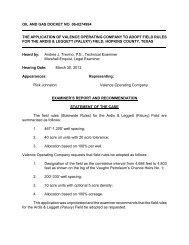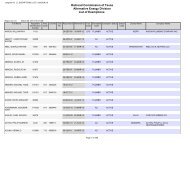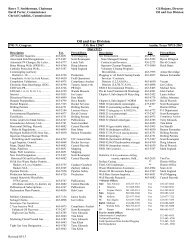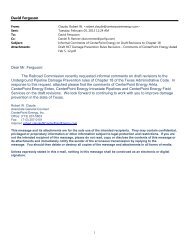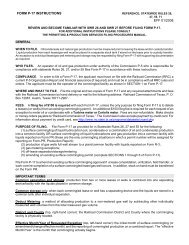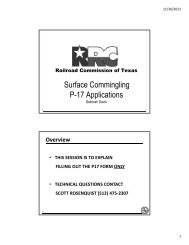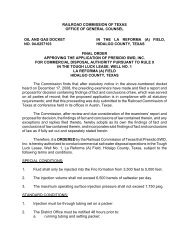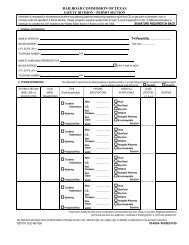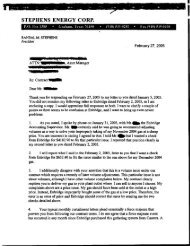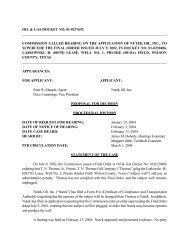G:\WP\Jmd\pfd\PFD-Nowak MIPA.wpd - The Railroad Commission ...
G:\WP\Jmd\pfd\PFD-Nowak MIPA.wpd - The Railroad Commission ...
G:\WP\Jmd\pfd\PFD-Nowak MIPA.wpd - The Railroad Commission ...
Create successful ePaper yourself
Turn your PDF publications into a flip-book with our unique Google optimized e-Paper software.
Oil & Gas Docket No. 06-0245016 Page 10<br />
Proposal for Decision<br />
According to Comstock’s Senior Regulatory Analyst, until the October 10, 2005, Form P-15<br />
filings were made, Comstock did not realize that it was allowed to assign 40 acres per well and not<br />
required to assign all acreage in the unit to the proration units for unit wells.<br />
A District Manager for Comstock’s East Texas District, who also holds a degree in petroleum<br />
engineering, presented production rate information for Well Nos. 1-3 through 1-8 on the Waldrop Gas<br />
Unit 1, beginning with the highest daily rate during the first two weeks of production and then the<br />
daily rate for successive 30 day periods over a total period of 180 days from the date of first<br />
production. Well No. 1-3 had a good initial rate, and production held up well over a 180 day period.<br />
Subsequent wells, except for Well No. 1-6, generally had lower initial rates and lower production<br />
during subsequent months. Cotton Valley wells generally exhibit rapid rate decline, on the order of<br />
60-75%, over 18 months and then the rate tends to stabilize. Well No. 1-6 had the highest initial rate<br />
of all unit wells, but then the rate declined rapidly. As Comstock moved south with drilling wells<br />
on the unit, initial rates declined significantly. <strong>The</strong> initial rates for Well Nos. 1-7 and 1-8 were<br />
significantly lower than previous wells, and the production rate dropped off faster. As compared to<br />
an initial rate for Well No. 1-3 of 2,615 MCFD, the initial rate for Well No. 1-7 was 1,530 MCFD,<br />
and the initial rate for Well No. 1-8 was 1,090 MCFD. At the end of 120 days, the comparative<br />
production rates for Well Nos. 1-3, 1-7 and 1-8 were: Well No. 1-3: 510 MCFD; Well No. 1-7: 305<br />
MCFD; and Well No. 1-8: 300 MCFD.<br />
Costs booked by Comstock to date for drilling and completing Well Nos. 1-7 and 1-8, which<br />
are the unit wells closest to <strong>Nowak</strong>’s leases, are about $1.3 million and $1.4 million, respectively.<br />
When Comstock made the decision to drill Well Nos. 1-3 through 1-8, Comstock estimated that it<br />
needed an ultimate recovery of 750-800 MMCF per well to make the wells economical. Based on<br />
initial rates and expected rate of decline, Comstock’s District Manager does not believe that Well<br />
Nos. 1-7 and 1-8 will pay out, and knowing what it knows today, Comstock would not have drilled<br />
these two wells. <strong>The</strong> other unit wells that are located within <strong>Nowak</strong>’s proposed 339 acre force pooled<br />
unit, Well Nos. 1-4 and 1-5, are expected to pay out. Comstock will not drill any additional wells<br />
in the southwestern part of the Comstock unit.<br />
Comstock’s District Manager believes that there is always mechanical risk associated with<br />
the drilling of wells. Based on Comstock’s experience with drilling of four wells on the 339 acres<br />
included in <strong>Nowak</strong>’s proposed force pooled unit, two of which are projected not to pay out,<br />
Comstock’s District Manager believes that if forced pooling is ordered, a 50% risk penalty would be<br />
appropriate.<br />
Comstock performed no engineering study of the radial drainage capability of Well Nos. 1-7<br />
and 1-8, and has not performed any reserve estimates for unit wells. Nonetheless, based on low<br />
initial rates and low daily production rates after 120 days of production, Comstock’s District Manager<br />
does not believe that Well Nos. 1-7 and 1-8 are draining any of the acreage covered by <strong>Nowak</strong>’s<br />
leases. He believes that a low initial rate correlates with a smaller effective drainage radius and that<br />
wells, such as the 1-7 and 1-8, making 300 MCFD after 120 days of production are draining less than<br />
40 acres.


